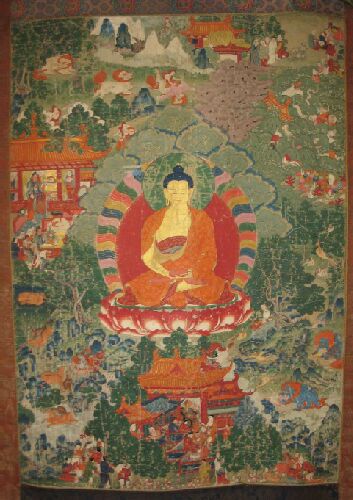
About the Meditation
Meditation session led by Sharon Salzberg
The guided meditation begins at 19:27.
For centuries Himalayan practitioners have used meditation to quiet the mind, open the heart, calm the nervous system, and increase focus. Now Western scientists, business leaders, and the secular world have embraced meditation as a vital tool for brain health.
Whether you’re a beginner, a dabbler, or a skilled meditator seeking the company of others, join expert teachers in a forty-five-minute weekly program designed to fit into your lunch break. Each session will be inspired by a different work of art from the Rubin Museum’s collection and will include an opening talk, and a twenty-minute sitting session.
This program is presented in partnership with Sharon Salzberg, the Interdependence Project and Parabola Magazine.


Related Artwork
Theme:Interdependence

Previous Lives (Jataka) of Buddha Shakyamuni
Previous Life Stories of the Buddha is a painting from a large set of approximately 21 paintings depicting 108 stories, created in a Central Tibetan Menri School painting style.
There are hundreds of Jataka (जातक JÄtaka) tales that describe the events and various previous births of Shakyamuni Buddha. In Himalayan and Tibetan culture, the Jatakas are commonly depicted in art and follow a famous Indian text called the Jatakamala, which narraties 34morality tales, often using animals as the central subject. This set of paintings depicts the original 34 stories, along with an additional 74. These 108 stories were compiled by the Third Karmapa Rangjung Dorje (1284″“1339).
Through the lens of compassion, selflessness, and generosity, the Starving Tigress tale (one of the Jataka stories) reminds us of the truth of interdependence.Born into a family renowned for its purity of conduct and great spiritual devotion, the bodhisattva became a great scholar and teacher. With no desire for wealth and gain, he entered a forest retreat and began a life as an ascetic. Here he encountered a tigress who was starving and emaciated from giving birth, and was about to resort to eating her own newborn cubs for survival. With no food in sight, the bodhisattva””out of infinite compassion””offered his body as food to the tigress, selflessly forfeiting his own life.
About the Speaker

Sharon Salzberg, cofounder of the Insight Meditation Society in Barre, Massachusetts, has guided meditation retreats worldwide since 1974. Sharon’s latest book is Real Love: The Art of Mindful Connection. She is a weekly columnist for On Being, a regular contributor to the Huffington Post, and the author of several other books including the New York Times bestseller Real Happiness: The Power of Meditation, Faith: Trusting Your Own Deepest Experience, and Lovingkindness: The Revolutionary Art of Happiness. Sharon has been a regular participant in many onstage conversations at the Rubin.
